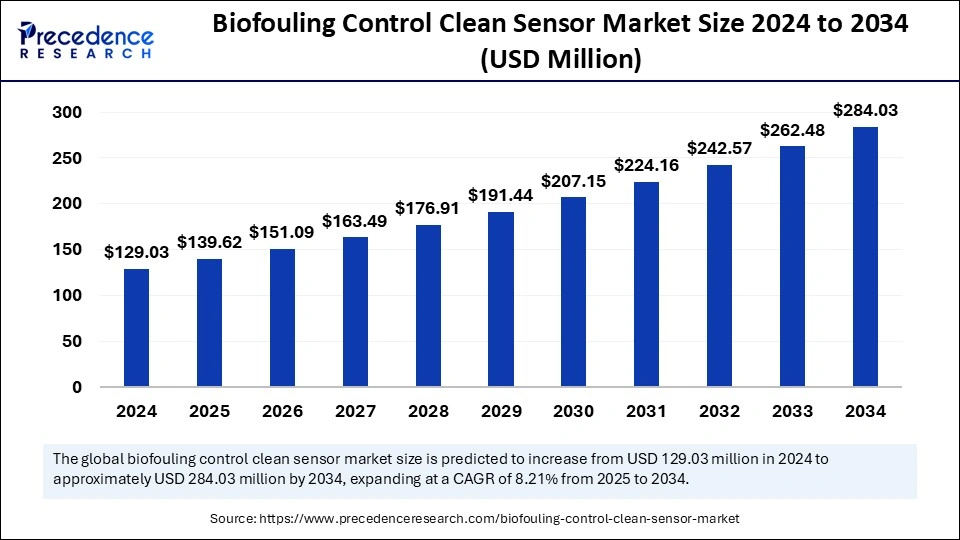The biofouling control clean sensor market is projected to grow from USD 129.03 Mn in 2024 to USD 284.03 Mn by 2034, with a CAGR of 8.21%.

Biofouling Control Clean Sensor Market Key Takeaways
- Asia Pacific dominated the global market with the largest share in 2024.
- Europe is expected to expand at the highest CAGR during the forecast period.
- By type, the electrochemical fouling control system sensor segment held the major market share in 2024.
- By application, the marine engineering segment contributed the biggest market share in 2024.
- By application, the industrial production segment is expected to grow at the fastest CAGR during the projection period.
Biofouling Control Clean Sensor Market Overview
The biofouling control clean sensor market is experiencing significant growth due to the increasing need for maintaining the efficiency and accuracy of sensor systems in marine, industrial, and environmental monitoring applications. Biofouling, caused by the accumulation of microorganisms, algae, and other biological matter on sensor surfaces, can lead to sensor degradation and inaccurate data collection. Biofouling control clean sensors utilize advanced technologies such as anti-fouling coatings, ultraviolet (UV) light, and electrochemical methods to prevent biofilm formation and ensure the longevity of sensor systems.
Industries such as oil and gas, aquaculture, water treatment, and marine research are increasingly adopting biofouling control technologies to enhance operational efficiency and reduce maintenance costs. The integration of artificial intelligence and machine learning algorithms in biofouling control systems is further enhancing the effectiveness and adaptability of these sensors, driving their adoption across diverse applications.
Drivers
The primary driver of the biofouling control clean sensor market is the rising demand for high-accuracy sensor systems in critical applications such as underwater monitoring, marine navigation, and industrial processes. Biofouling can significantly impact the performance of sensors by causing signal attenuation and data inconsistencies, making it essential for organizations to invest in biofouling prevention solutions. The increasing use of sensors in aquaculture to monitor water quality and environmental parameters is also contributing to market growth.
Additionally, the growing emphasis on environmental sustainability and the need to reduce the ecological impact of industrial activities are driving the adoption of biofouling control technologies. Governments and regulatory bodies are encouraging the use of biofouling control solutions to minimize the impact of biofouling on marine ecosystems and promote the use of eco-friendly sensor maintenance practices.
Opportunities
The biofouling control clean sensor market presents substantial opportunities for growth in emerging industries such as offshore renewable energy, deep-sea exploration, and smart water management. The increasing deployment of autonomous underwater vehicles (AUVs) and remotely operated vehicles (ROVs) for oceanographic research and marine exploration is driving the demand for reliable and biofouling-resistant sensor systems. The development of nanotechnology-based anti-fouling coatings and the use of bio-inspired materials are creating new possibilities for enhancing sensor longevity and performance.
Additionally, the growing adoption of Internet of Things (IoT) devices and smart sensor networks in environmental monitoring and industrial automation is expected to create new avenues for the application of biofouling control technologies. The integration of real-time data analytics and predictive maintenance capabilities in biofouling control systems is also expected to enhance their market potential.
Challenges
Despite the promising growth outlook, the biofouling control clean sensor market faces several challenges that could hinder its progress. One of the primary challenges is the high cost associated with the development and deployment of advanced biofouling control technologies. Implementing biofouling prevention solutions often requires significant investment in research and development, which may pose a barrier to market entry for smaller companies. Ensuring the long-term effectiveness of anti-fouling coatings and biofouling control systems in harsh environmental conditions is another challenge faced by market players.
Additionally, the complexity of integrating biofouling control technologies with existing sensor systems and the need for regular maintenance and performance validation can increase operational costs and complexity.
Regional Insights
North America dominates the biofouling control clean sensor market, driven by the presence of leading sensor technology providers and a strong focus on marine research and environmental monitoring. The United States, in particular, is a key market, with significant investments in underwater sensor technologies and biofouling prevention solutions. Europe is another prominent region, with countries such as the United Kingdom, Germany, and Norway emphasizing sustainable marine practices and the adoption of biofouling control technologies
The Asia Pacific region is witnessing rapid growth due to the increasing deployment of sensor systems in aquaculture, water management, and offshore energy applications. China, Japan, and Australia are driving market expansion in the region through investments in environmental monitoring and marine research. Latin America and the Middle East & Africa are gradually adopting biofouling control technologies, driven by increasing awareness of the benefits of clean sensor systems in industrial and environmental applications.
Recent Developments
Recent developments in the biofouling control clean sensor market include advancements in nanotechnology-based anti-fouling coatings that offer enhanced durability and effectiveness in preventing biofilm formation.
The integration of artificial intelligence and machine learning algorithms in biofouling control systems is enabling real-time monitoring and adaptive response to changing environmental conditions. Strategic partnerships between sensor manufacturers and research institutions are driving the development of innovative biofouling prevention solutions. The adoption of electrochemical cleaning methods and UV-based disinfection technologies is also contributing to the enhancement of biofouling control capabilities.
Biofouling Control Clean Sensor Market Companies
- EVAC Group
- Yokogawa Electric Corporation
- ABB Ltd.
- KROHNE Group
- Veolia Water Technologies
- ALVIM SRL
- Sea-Bird Scientific
- ANB Sensors
- Green Eyes
- AML Oceanographic
- RBR Ltd
- Hydrolab
- Aanderaa
Segments Covered in the Report
By Type
- Electrochemical Fouling Control System Sensor
- Stoichiometric Fouling Control System Sensor
By Application
- Marine Engineering
- Aquaculture
- Industrial Production
- Others
By Geography
- North America
- Europe
- Asia Pacific
- Middle East & Africa
Ready for more? Dive into the full experience on our website!